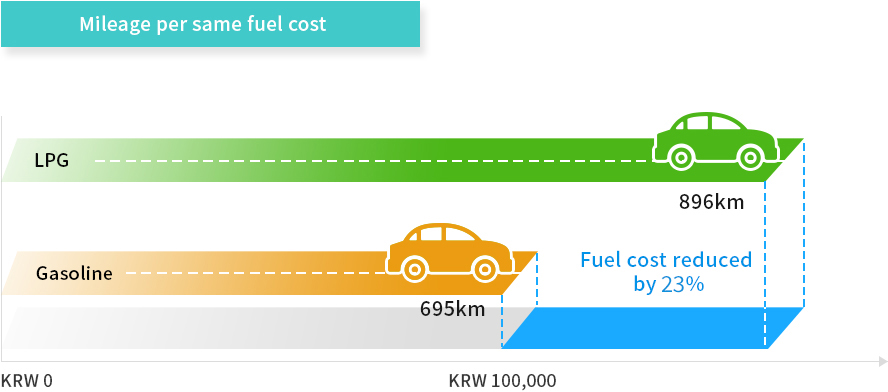
- About US
- LPG Industry
LPG Industry

- LPG R&D
- Related Link
Related Link

LPG R&D
 LPG R&D About LPG Vehicles
LPG R&D About LPG Vehicles
LPG R&D
About LPG Vehicles
What is LPG vehicle?
The LPG vehicle produces little particulate matter and nitrogen oxides, marking its eco-friendly feature, and its low fuel cost also makes it economical. The vehicle boasts excellent quietness due to its low noise and vibration, while its safety has been widely proven through various safety certifications for its safety devices and components and crash tests
Cleanness of LPG vehicles
Due to fuel cleanness, the LPG vehicle emits very little particulate matter (PM10) which causes various respiratory diseases and lung cancer, and it also emits significantly less amount of nitrogen oxides (NOx), which serve as the main cause of generation of secondary particulate matter.
Comparing the nitrogen oxide emissions of vehicles by fuel type, the average nitrogen oxide emissions of LPG vehicles are significantly lower than those of other types. In outdoor road tests similar to the actual driving environment, in particular, LPG vehicles emitted only 1/93 of the nitrogen oxides emitted by diesel vehicles.
Comparison of Nitrogen Oxide Emissions of Vehicles by Fuel Type
| Exhaust gases | |
|---|---|
| Nitrogen oxide | Indoor test |
| Outdoor road test | |
| Gasoline | Diesel | LPG |
|---|---|---|
| 0.011 | 0.036 | 0.005 |
| 0.020 | 0.560 | 0.006 |
* Source: Survey conducted by the National Institute of Environmental Research (2015, average figures for each of the nine types of gasoline vehicles, 32 types of diesel vehicles, and four types of LPG vehicles)
Social Cost by Pollutant and Fuel Type
| Category |
|---|
| CO |
| NOx |
| SOx |
| VOC |
| PM2.5 |
| CO2eq |
| Social cost per unit |
| Gasoline | Diesel | LPG |
|---|---|---|
| 434.0 | 105.3 | 146.1 |
| 94.3 | 832.4 | 48.1 |
| 0.2 | 0.2 | 0.1 |
| 5.5 | 2.3 | 0.5 |
| 0.6 | 107.8 | 0.0 |
| 66.4 | 78.2 | 51.7 |
| KRW 601/ℓ | KRW 1,126/ℓ | KRW 246/ℓ |
* Source: Ministry of Environment
Economic benefits of LPG vehicles
The price of LPG is about 55-60% of the price gasoline, and even when considering the fuel mileage of LPG vehicles, it is still at 65-70% of the price of gasoline. Comparing When comparing the mileage between LPG and gasoline vehicles per same fuel cost (KRW 100,000), the gasoline vehicles and LPG vehicles travel 695km and 896km, respectively, so the latter saving could save at least 23%.
Mileage per Same Fuel Cost (KRW 100,000)
| Category |
|---|
| Gasoline |
| LPG |
| Gas mileage (Average of midsized cars) |
Price (Average in 2022) |
Mileage |
|---|---|---|
| 12.4km/ℓ | KRW 1,813 | 695km |
| 9.7km/ℓ | KRW 1,082 | 896km |



 KOR
KOR

